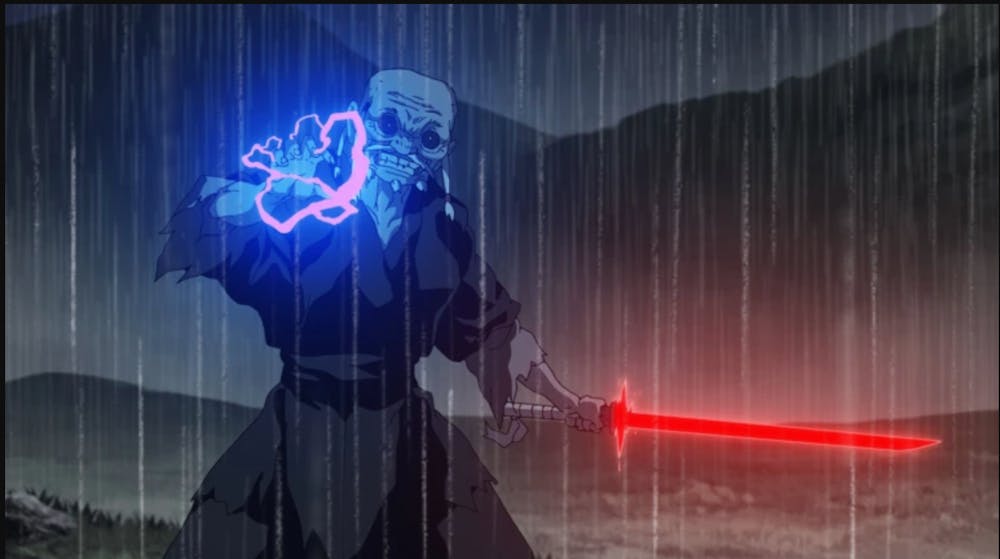Let’s imagine “Star Wars” in a new light. Those typical themes of the American West hero are well trodden, and the imperialist narratives are loud and clear after 9 main films. But “Star Wars: Visions” is an example of how we can dream better and create new ideas around what “Star Wars” is and what it can be. The Disney Plus series is a collection of cinematic shorts, created by seven different Japanese animation studios. Nine episodes create a diverse, vast universe with distinct artistic drive, and the original lore acts as a loose inspiration guide to create something new, brilliant and long overdue.
“Star Wars” is no stranger to animation. “Star Wars: The Clone Wars” colored the politically driven conflict briefly explored in the prequels trilogy and turned out to be a popular entry among fans. Other shows like “Star Wars: Rebels” and “Star Wars: Resistance” added texture to the already rich lore with kid-focused animation styles, yet all three series worked well within the bounds set by George Lucas’ main trilogy. The same can go for the standalone Star Wars stories, “Rogue One” and “Solo”: they are interesting, but not fundamentally different from the films that came before. Star Wars needed something new and untested, and “Visions” delivered just that.
“Visions'' is an experiment in creativity, pushing the boundaries of what “Star Wars” means and what it can look like. Every episode is distinct in style, color and tone, but layered with cultural imprints from the studios that made them. “Episode 1: The Duel'' draws from jidaigeki sources, mimicking old samurai films in how desaturated the colors feel, how the grass flies in the breeze or how characters glide across the screen. “Episode 6: T0-B1 '' on the other hand, loosely resembles the plot of “Astro Boy” but is designed with chalk-like backgrounds and an electronic soundtrack mesmerizing in its diverse instrumentation. From these two episodes alone, it’s clear to see how the “Star Wars”universe can be viewed in dynamic, fulfilling ways by skillful anime directors and top-tier animation studios.
Each episode brought the viewer into the conflict quickly, introducing a new world, cast of characters, and history in a matter of minutes. “Visions” was thrill ride after thrill ride, with clear set-up and stakes resolved by the end. But no one story was complete, as most episodes depicted the hero departing toward a new adventure or even greater conflict. This left me pondering several worlds and their narrative potential days after watching.
Since episodes offered variety and appreciated novelty to the series, it inevitably meant some stories were more enjoyable than others. Some episodes experimented with morally gray characters better than any “Star Wars” film had before, while some episodes featured stories that were new but not nearly as engaging. That’s not to say anyone should skip out on any of these episodes. All show so much artistic liberty so every viewer can admire at least one aspect from each, and 15-minute episodes cut out a lot of the investment other “Star Wars” films and series require. Another potential weakness is that it’s also very easy for these stories to blend together, especially watching episodes back-to-back. Each anime studio included a lot of what makes the trilogies recognizable with lightsaber duels and heroic figures. It gets repetitive, sure, and it would be a major problem… if this was any normal series. None of these stories are connected in the slightest, and they should instead be treated as individual pilot episodes for nine completely different “Star Wars” series. With that mindset, it was easier for me to enjoy “Visions” for what it is: a collection of “Star Wars” shorts built and inspired by Japanese film, culture and art tradition.
Creativity and diversity truly sum up the beauty of “Visions”. Each studio took their opportunity to create stories with the utmost care, adding something distinct from all other “Star Wars” movies and shows up to this point. If anything, this series appeals to the imagination of fans across the globe who know what this limitless, intergalactic universe holds. These creators are “Star Wars” fans, like so many of us, and it’s powerful to see content that inherits identities, traditions and experiences that people from different parts of the world can relate to and enjoy.
This intergalactic franchise has gone beyond the George Lucas films of old. The Skywalker saga might be the definitive version of “Star Wars” (which originally drew from Japanese history), but “Visions” brings those influences to the forefront with flair and confidence. So many stories go untold in this universe but shows like the “Mandalorian” have already proven that interesting and smaller stories are welcomed and desired. Nine animated vignettes might just be the start needed to turn the vast, complex and fantastical “Star Wars” universe into a diverse, multicultural franchise better representative of the people who watch, love and live through this story from long ago, in a galaxy far, far away.
Get The Chronicle straight to your inbox
Signup for our weekly newsletter. Cancel at any time.

